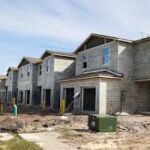
May 28, 2025
Build to rent (BTR) homes continue to rise in Tampa Bay, a top 10 national market for the sector since 2023, but it remains to be seen if the trend continues to grow here and nationally.
A recent report from the Tampa Bay Business Journal revealed that the BTR inventory has grown by 300 percent over the last five years with an addition of 2,192 new single-family rentals. A Point2Homes analysis of Yardi Matrix Data ranks Tampa as the ninth largest BTR market. In 2023, it ranked sixth – but the change reflects an increase in other markets across the nation and in Florida.
Homebuilders have put nearly 100,000 new BTR properties in the pipeline across the nation in 2024, according to Realtors.com. That comes after they set a record in 2024 by completing 39,000 rental single-family homes, a 15 percent increase compared to 2023.
In Florida, Orlando leads in the sector with approximately 3,000 homes under construction. Jacksonville statistically ties Tampa with 2,000 homes in progress. Other Florida municipalities ranking among the top 10 include Wesley Chapel, Jacksonville, Wesley Chapel, Kissimmee, Port St. Lucie, St. Augustine and St. Cloud. According to the Business Observer, a total of 63 communities are under construction across the state.
Robert Dietz, chief economist for the National Association of Home Builders, estimates that 10 percent of single-family home construction is built to rent. The reasons for the increase are numerous. Start with the obvious: the rising price of homes and the stagnant mortgage rates have more buyers opting to play the waiting game and rent while waiting for positive changes.
Families also can gain the advantages of a “new home” feel without having to put down a sizable down payment. Post-pandemic influences also factor in with builders creating office space for those working from home. And some in the upcoming generation want more private spaces and no worry about neighbors living above or below them.
Home builders also have their reasons. For some, it’s a matter of converting developments until the market dynamics prove more favorable. Other builders are backed by investors looking for a solid return in a volatile home building market.
Yet while some see this as a clear boom, other experts offer a more tempered view. Dietz, the NAHB economist, recently wrote that, “BFR market will likely retain an elevated market share. However, in the near term, SFBFR construction is likely to slow until the return on new deals improves.” Dietz noted that year over year, the built-for-rent sector is flat based on NAHB’s analysis of data from the Census Bureau’s Quarterly Starts and Completions by Purpose and Design.
Realtor.com also noted in its reporting the built to rent could make it more difficult for everyday Americans to buy homes in the long run by reducing for-sale inventory levels.
"So much of the new stock of homes being built is going directly into the rental portfolios of these large companies, and potential homebuyers never have a chance to bid on them in the way they once would have," Georgia State University associate professor Taylor Shelton told local Atlanta television station WXIA.
Questions have also been raised about the quality of management at BTR developments. Some municipalities have put in restrictions calling for a single rental management company for development, while a few counties across the nation have outright banned future BTR communities.
